No one likes Sword and Sorcery more than I do.
Well, all right, probably Robert E Howard, JRR Tolkien and a zillion-and-one other people like Sword and Sorcery more than I do.
I did, however, as a youth, have enough fondness for the field to buy the occasional comic, of that genre, that didn't have the word "Conan" in the title.
Beowulf #3 was one of those.
I must confess that, at the time, I was a little bewildered by it, as it didn't feel anything like I'd expect a comic about that hero to be. Nor did his attire look how I'd always assumed it would.
But, now, all these years later, will I dig it, by Crom?
We kick off with the hero and his gang on a ship being attacked by a big octopus thingie. Happily, that octopus thingie promptly explodes like a balloon when Beowulf hits it with his big, spikey mace.
If only all octopus thingies were so easily thwarted.
In the aftermath of this, we discover that, as well as Beowulf's gang being on board, he also has an untrustworthy companion called Unferth who's clearly to Beowulf's mission what Doctor Zachary Smith was to the Robinson family's.
Beowulf, you see, is on a quest to drink the venom of the Black Viper which, in combination with the Ambrosia of the Zumak, will give him the strength he needs to defeat the dastardly Grendel.
This quest now brings our hero to an island, with a skull-shaped mountain, populated by potentially hostile pygmies.
Showing no inclination to act like a traditional barbarian hero, Beowulf tries to befriend them but they're having none of it, as they worship the Black Viper, and their king thinks its powers are what's keeping him alive and healthy. They are, therefore, reluctant to let him kill it.
The misunderstanding amicably sorted out by a quick fight with a giant pygmy and a hefty dose of cheating, Beowulf goes to the cave where the Black Viper lives and, with his bare hands, murders it before drinking its venom.
That's that job sorted. Now to try and find some Ambrosia.
Plotwise, it's very basic, Beowulf and his gang simply go from place to place and fight whatever menace meets them there, usually defeating it with no huge effort on the hero's part. Even the Black Viper which is meant to be the tale's main menace is slaughtered within a few panels, with seemingly little peril to the protagonist.
The story's real strength is its art by Ricardo Villamonte, which is refreshingly uncluttered, using no elements that aren't necessary, but is filled with elegance and style, throughout.
Writer Michael Uslan, meanwhile, may have produced an unimaginative and linear plot but at least he does inject proceedings with a humour that's often lacking in such tales. Although, having Beowulf's resident sorcerer The Shaper invoke the name of Harry Houdini, at one point, does seem a little strange.
In fact, this is possibly the strip's real flaw, in that Uslan seems to be finding it seriously hard to be serious, to a degree that it could be argued fatally robs all proceedings of tension.
There's also the question of Uslan's method for naming characters. Clearly, he's a lover of simply getting modern names and making them sound, "exotic."
So it is that we get the likes of Nan-Zee and Will-Zon. I'm willing to put my neck on the line, right now, and say that Nancy and Wilson are not good names for characters in a Scandinavian epic.
In terms of feel, before one opens the book, one might expect a hefty dose of Conanocity but, in fact, it feels more like a mash-up of Killraven and The Golden Voyage of Sinbad. Indeed, the giant octopus fight at the start does bring to mind a similar battle at sea that Don McGregor and Craig Russell once gave us in that Martian-happy strip.
But there is one mystery.
Why's the story called Man-Apes and Magic when there are barely any signs of man-apes in it? Clearly, someone in the story-titling department was far too keen on simians, for his own good.

























































































































